How to Use Clicker Training (Benefits, Exercises and Tips)
- Anja Boecker
- Updated: 2023-06-08
Are you ready to train your dog but have had little success? Your dog just won't listen to your commands? Don't panic, clicker training could be the answer!
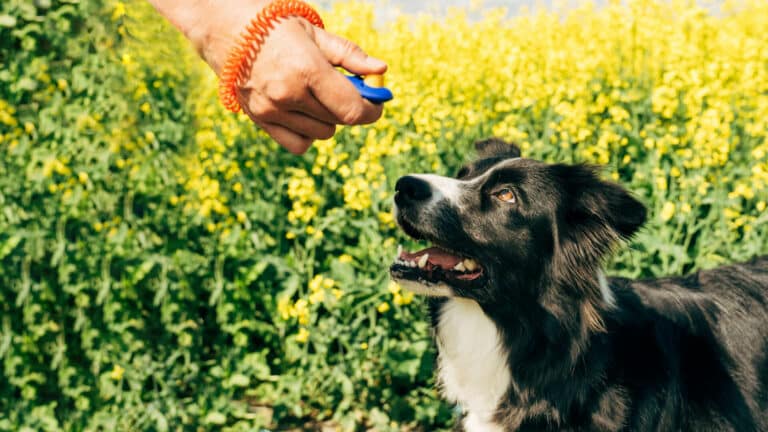
What Is Clicker Training?
Take your dog training to a whole new level with clicker training! With a simple click, you signal to your dog that he has done something right. This way, your dog will learn what you want much faster and make progress much more quickly.
Behavioral research in recent years has shown that animals learn better when they are rewarded for correct behavior. Not only that, but clicker training is much more fun than traditional training!
From basic training to tricks to leash walking, clicker training is great for any type of training.
Why Clicker Training Makes Sense
Clicker training is an effective and pet-friendly way to teach your dog new behaviors or correct unwanted ones. Here are some reasons why you should consider using clicker training with your dog:
- Positive reinforcement: Clicker training is based on the principle of positive reinforcement. It involves using rewards (such as treats, praise, or playtime) to encourage desired behavior instead of punishing undesired behavior. This can help build a positive relationship between you and your dog.
- Clear Communication: The clicker gives your dog clear and consistent audible feedback exactly when he performs the desired behavior. This can help eliminate misunderstandings and make it easier for your dog to understand what behavior is being rewarded.
- Learn Faster: Because the clicker gives your dog immediate feedback, he can learn and understand new commands or behaviors faster.
- Encourage Creative Thinking: Clicker training can help develop your dog's problem-solving skills. It encourages your dog to think for himself and try different behaviors to get a reward.
- Flexibility: You can use clicker training for a variety of commands and behaviors, from simple commands like "sit" or "stay" to more complex tricks and behaviors.
- Binding: Clicker training can help strengthen the bond and understanding between you and your dog. It can be a fun and rewarding activity for both of you.
However, it is important to remember that, as with any training method, patience and consistency are required to achieve success. Some dogs may need a little more time to understand the principle of clicker training, but with patience and practice, most dogs can benefit.
Dogs Learn Better With Rewards
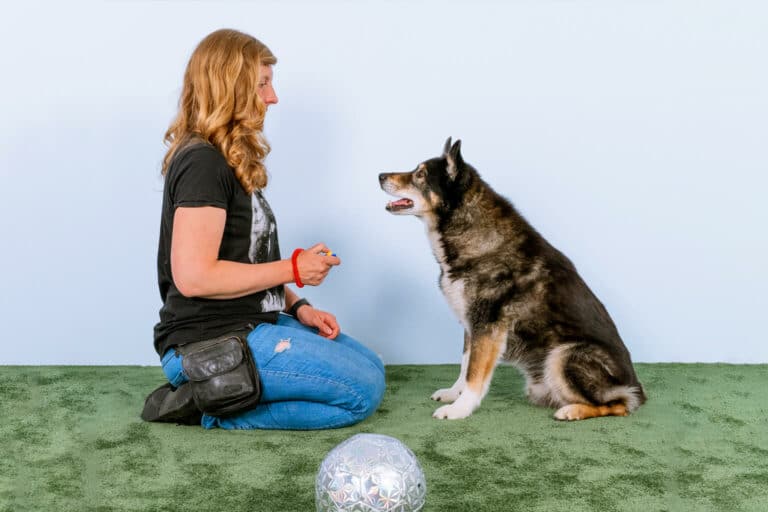
The best way to train your dog is by reward. It's no secret that most dog owners train their dogs this way.
Dogs learn quickly when they realize that a certain behavior is rewarded. They will then repeat that behavior over and over again, hoping for more rewards.
Reasons for Rewards:
- A Positive Bond: Rewards help build a positive bond between you and your dog. Your dog will experience training as a time of joy and anticipation.
- Encourage Desirable Behavior: Rewards show your dog exactly what behavior you want him to do.
- Reduce Anxiety and Stress: Punishment can cause fear and stress in your dog, which can lead to behavioral problems. Rewards, on the other hand, promote a relaxed and positive learning environment.
- Faster and More Effective Learning: Dogs trained with rewards tend to learn faster and retain what they learn. They are also more motivated to learn new things.
- Better Relationship: Rewards make training a joint activity that strengthens the relationship between you and your dog. Punishment, on the other hand, can strain the relationship.
- Fostering Trust: Rewards help build trust between you and your dog. Punishment, on the other hand, can undermine trust.
The clicker makes a clicking sound that says, "Good job!" After the click, there is a reward. This can be a treat. It can also be a toy that your dog likes to play with. You can also pet your dog or praise him.
The reward should be something your dog really likes. It is important that the reward comes immediately after the click. That way your dog knows he did something right.
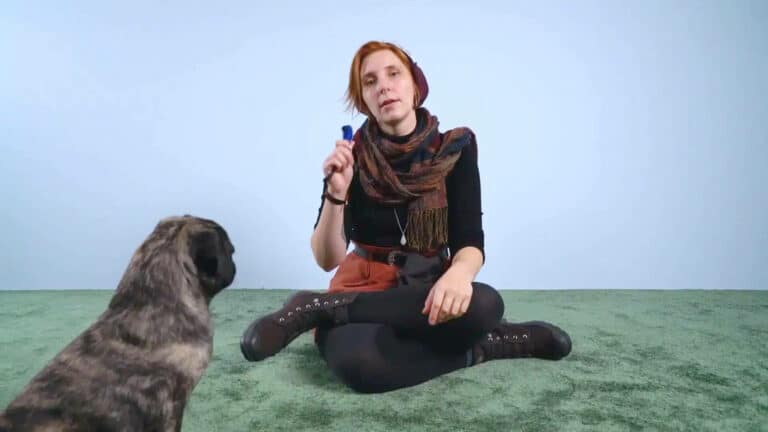
Link the Reward to the Action
Successful clicker training is all about timing. It is important that you click and reward immediately after the desired behavior so that your dog knows what he just did right.
The faster the reward comes, the more reliably your dog learns. In conventional training, it is difficult to give praise at just the right time.
For example, if you want your dog to walk next to you without a leash, you need to praise him exactly when he is next to you. But by the time you give him a treat, too much time may have passed.
With clicker training, it's much easier to catch the right moment and train your dog quickly and effectively.
How to Use a Clicker for Dog Training
A clicker, a small device that makes a distinctive clicking sound when pressed, is a great way to show your furry friend when he or she has done something right.
The sound is loud enough for your dog to hear and stand out from the surrounding noise.
When your pet performs the desired behavior, simply press the clicker and give the reward. This way, your pet associates the click with the reward and knows what he is being rewarded for.
The conditioning effect ensures that the clicker alone has almost the same effect as a treat.
Instead of a clicker, you can use other sounds such as a whistle or a specific word as a signal. It is important that you do not use the signal in everyday life so that it retains its effectiveness.
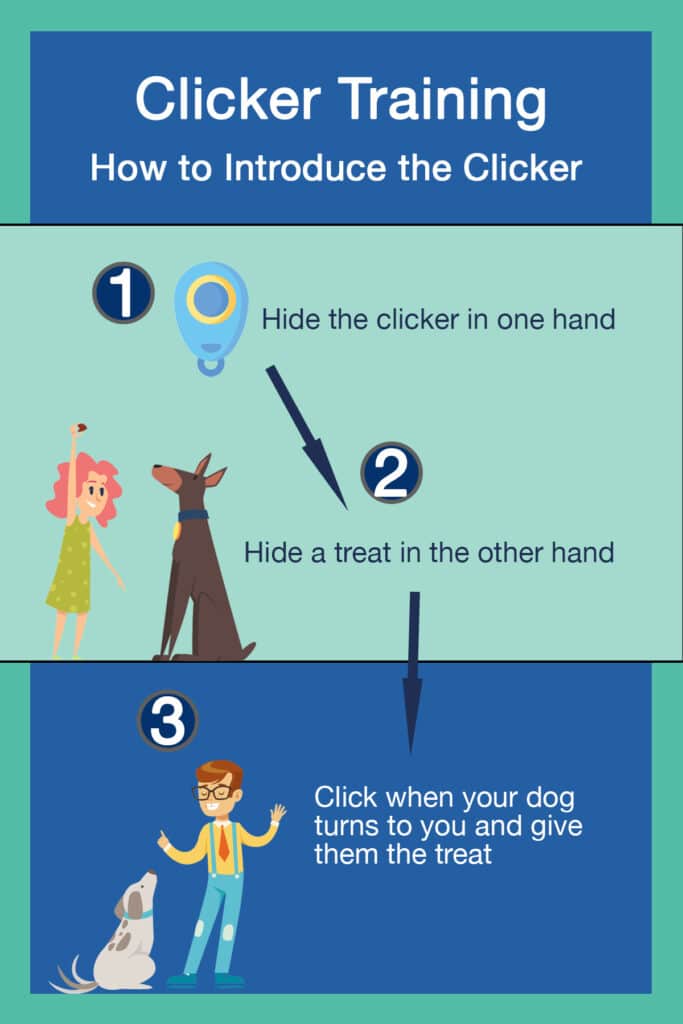
5 Advantages of Clicker Training
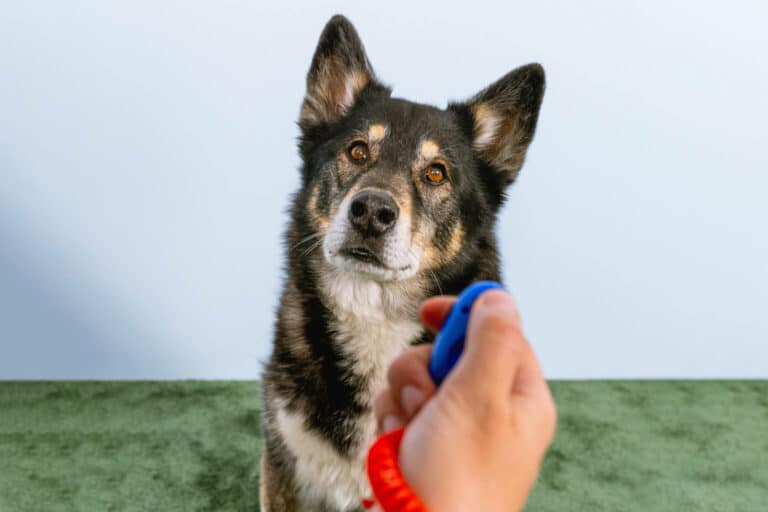
1) Fast Learning Effect
Your furry friend needs to associate the reward with the behavior. Clicking can now make that connection even faster and more accurate.
It allows him to know exactly when he has done something right. This makes it much easier to implement what you have learned.
This method also encourages your dog's problem-solving skills and creativity. Your dog will be looking for new ways to get the click back.
He learns that he can independently find new ways to get the reward he wants. This realization can help him learn more flexibly and quickly in other situations as well.
2) Complicated Exercises Possible
With conventional methods, it is often not possible to teach more difficult exercises. However, with a clicker and a little patience, even the most complicated tricks can be learned.
Clickers are also used in the training of police dogs or in the medical training of zoo animals to facilitate the veterinary examination of their behavior.
3) You Can Use Clickers With Any Dog
Young or old, big or small, fat or thin - clicker training is for every dog! Even pets that are generally considered less able to learn can benefit from this effective method.
Whether the dog already has gray hair or is still in its infancy, clicker training can still help older dogs learn new tricks and young puppies improve their skills.
4) There Are No Punishments
Clicker training is reward-based - a huge advantage! Your dog will progress much faster because he's not afraid to make mistakes.
On the contrary, he dares to be creative and try out more. All without physical contact. Even shy or anxious dogs can be trained without pressure or fear, which strengthens the trust in the relationship between dog and owner.
5) It's a Fun Training Method
There is one thing that makes clicker training so special: it is incredibly fun!
Your dog will love training with you and seeing how he gets treats by clicking. This is a great incentive for him to do his best and improve his performance.
It's also a great way to strengthen your relationship with your dog and spend quality time with him. The exercises are designed to be more like a game than a workout and always provide variety.
This way it never gets boring and your dog is always motivated to keep going.
Are There Disadvantages to Clicker Training?
As with any training method, there are potential drawbacks to clicker training that vary from dog to dog and trainer to trainer. It is important to know, however, that these disadvantages can be minimized or avoided with a little preparation.
For example, some dogs may find the loud click uncomfortable or even frightening. To reduce the volume of the clicker, silent clickers or clickers with adjustable volume can be used.
Another disadvantage is that you have to carry the clicker with you at all times. You can remedy this by attaching the clicker to your keychain or belt loop. That way, you will always have it with you when you are out and about with your dog.
Clicker training also depends on timing the click to match the right behavior from the dog. It may take you a while to master this timing. But don't worry, if you practice diligently, you'll soon get the hang of it!
Problems + Solutions
Although clicker training has many benefits, there are some problems that can occur during training:
Wrong Timing: It is important to click exactly when the dog is performing the desired behavior. If you click too early or too late, your dog may become confused and learn the wrong thing.
Excessive Use of Treats: Some dogs can become addicted to treats. They will only listen to commands if they know they will get a treat in return.
Overtraining: Like people, dogs can become overwhelmed or stressed by too much training. It is important to vary the training and take breaks.
Expect Progress Too Quickly: Sometimes the dog is expected to understand all commands immediately. This can lead to frustration. Every dog is different and learns at its own pace.
Lack of Consistency: It is important to be consistent with clicker training. The clicker should always be used when the desired behavior is exhibited and should always be followed by a reward.
Remember, every problem is solvable. With patience, understanding and consistency, you and your dog will enjoy clicker training.
5 Tips and Tricks for Clicker Training
Are you interested in clicker training? Or are you looking for ways to improve your training?
If so, here are a few tips to make your workout more effective:
1) Familiarize yourself with the clicker before training
Your dog hears the clicker sound for the first time and it seems strange? He may not yet associate the sound with a reward. Even during the first few training sessions, he may not know exactly what is being asked of him.
That's why it's important to use the clicker before training, so that your dog already associates the sound with a reward.
You can also use the clicker outside of training and reward your dog immediately after. This will quickly teach your dog that the sound indicates a reward.
2) Be Consistent About Clicker Training
If you want your dog to learn an exercise quickly, lots of rewards will help. If he's only rewarded occasionally for a particular behavior, he'll need more time to make the connection between the reward and the behavior.
Feel free to use the clicker up to 15 times per minute when practicing something new.
But make sure the training session is not too long. Your puppy needs to be able to concentrate.
3) Reward Your Dog After Clicking
Every time you click, you promise your pet a treat. If you click without rewarding him, he will be disappointed. The effect of associating the click with something good would gradually be lost. Practicing with the clicker would no longer make sense.
Therefore, every time you click, you must keep your promise and reward your pet.
4) Easy Start
Want to teach your dog new tricks? Then it is important to start slowly.
Remember that your dog, like you, will need time to adjust to the new training method. Start with simple exercises and work your way up.
At the end of this chapter, you will find some beginner exercises to help you get started.
5) Don't Scold Them
Clicker training puts you in a passive role, responding only to your dog's behavior. When he does something right, you click. If he doesn't do something well, he doesn't get a reward.
You don't have to show your dog what to do. Let him figure it out on his own. This will make him eager for the next click and the reward that comes with it, and will make him more creative.
Through repetition, he learns what to do. This encourages his creativity and is fun for both of you!
3 Exercises for Beginners
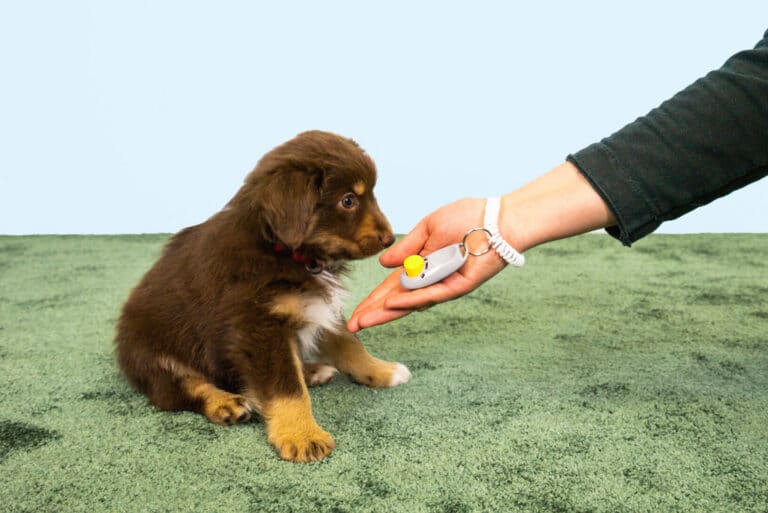
If you are new to clicker training, start slow with simple exercises. It will be a lot of fun.
The exercises presented here are only suggestions. Feel free to modify them or come up with your own ideas to add variety to your workout.
1) Control Impulses
This exercise is best done with two people. One person operates the clicker while the other person holds their hands out in front of the dog. One hand holds a treat and the other is empty. Both hands are clenched into fists so the dog cannot tell which hand has the treat.
The goal of the exercise is for your dog to touch the empty hand with his snout to get the treat in the other hand. It may seem difficult to teach your dog this, but with the clicker he will quickly understand.
Each time your dog briefly looks away from the wrong hand, click and reward him. On the next repetition, reward him first for looking toward the empty hand and then for approaching it.
You'll be amazed at how quickly your dog realizes that he has to move away from the food hand to get the treat. This exercise is not only fun for both of you, but also helps your dog's attention and concentration.
2) Target Stick
Target training involves having the dog touch a specific point on a long object, the target, with its muzzle. This can be a pointing stick, a stick, or even a fly swatter - the important thing is that the tip is different from the rest of the object, such as color or shape.
To introduce your dog to pointing, begin by simply rewarding him for showing interest in the stick. Over time, the click will be triggered only when he approaches the tip. Eventually, the only reward will be when he actually hits it.
Once your dog has mastered this task, you can use it for leash training or tricks. Feel free to vary the object you use as the target stick - this will keep the task interesting and your dog motivated.
3) Keep up the Challenge
Once you and your dog have mastered a few clicker exercises, you can get creative and try new things. Here are a few ideas:
How about your dog learning to push, poke, or retrieve objects? He can also learn to place objects in crates or sit in them.
Creative toys can be a puzzle for your dog and keep him curious. They do not have to be typical dog toys. Children's toys are another option.
Skateboarding is very popular, but not for every dog. Small dogs can learn if they are not afraid.
Parkour is suitable for all dogs because there are different obstacles to overcome.
Frequently Asked Questions
A clicker is a small, handy device that makes a distinctive clicking sound when pressed. This sound is used to train dogs or other animals by associating it with a positive reward.
With clicker training, you can simultaneously show your dog that he has done the right thing - without physical contact. The dog understands very quickly when he has done something right. As a result, animals learn faster and even fearful dogs are easier to train. Clicker training is a gentle and effective way to work with your dog.
Clicker training works with dogs of all ages and breeds. Puppy or senior does not matter. Clicker training can be used to achieve quick training results.
To successfully train your dog with the clicker, first get him used to the sound of the clicker. To do this, give him a treat every time you click. Once your dog associates the sound with a reward, you can begin the actual training. It is important that you click every time your dog performs the desired behavior. This way he will quickly understand what is expected of him and will be motivated to continue learning.
Clickers for dogs are available at most pet stores and online. A clicker usually costs less than $5. There is not much to consider when buying, most devices will do the job.
Conclusion
Clicker training is a fantastic way to enhance and expand your dog's training. It is not only great for basic training, but also for leash walking and learning tricks. With clicker training, the sky's the limit for you and your dog.
This playful form of training strengthens your relationship with your dog and helps shy or anxious dogs. Clicker training is fun!
Before you start training your dog, familiarize him with the clicker. Always click at the right moment and reward your dog immediately. Once you are both comfortable with the clicker, you can begin many new exercises that increase the level of difficulty.
What are you waiting for? Grab a clicker and let's go!

My name is Anja Boecker, and I am a certified dog trainer and behavior consultant. With these articles, I want to help you to understand your dog better and to build an inseparable bond.
Share Now:

